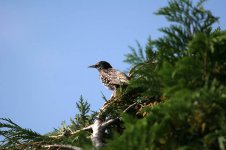Ashley beolens
Breeding the next generation of birders.
This is my first attempt with my new SLR set up.
Canon EOS 20D, 100-400 IS lens.
Had the setup on Av (apature priority) ISO 100. Hand held at 400 zoom.
Be gental, but how should my settings have been (unfortunatly not much choice in photo matter, theres not much where I live, so had to shoot looking up).
Saved at a low setting and reduced in size to 800 x 533 (anyone tell me why I get an extra pixel in hieght with this camers, e.g 600 x 401?)
Canon EOS 20D, 100-400 IS lens.
Had the setup on Av (apature priority) ISO 100. Hand held at 400 zoom.
Be gental, but how should my settings have been (unfortunatly not much choice in photo matter, theres not much where I live, so had to shoot looking up).
Saved at a low setting and reduced in size to 800 x 533 (anyone tell me why I get an extra pixel in hieght with this camers, e.g 600 x 401?)




